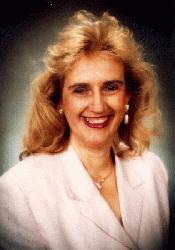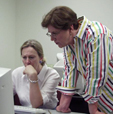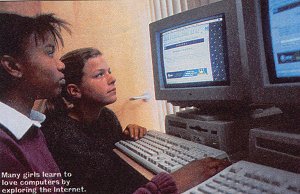
 
Spotlight on Teachers |
||
 Cynthia Lanius, CRPC Associate Director of Education, Outreach, and
Training
Cynthia Lanius, CRPC Associate Director of Education, Outreach, and
Training
For the past decade, the CRPC's Education/Outreach Program has focused on training and encouraging new generations of scientists that represent the full spectrum and diversity of our population, from kindergarten through adult education. Support for and development of K-12 math and science programs is especially critical if our girls and boys are to have the tools and knowledge they need to participate in science and technology fieldsthe backbone of our country. "The country is in danger of losing critical ground unless immediate steps are taken to encourage and inspire members from the entire population to become involved in the ever-changing world of computational science and engineering, as well as in other engineering and scientific fields," says Richard Tapia, CRPC Director of Education and Human Resources. "Including the broadest cross-section of people also helps us better understand what science is about and helps us overcome the problems that occur when science isolates itself from the rest of society." Recent anti-affirmative action legislation has amplified the need for creative and effective ways to increase minority participation in the sciences. It is important that these efforts begin when students are young. Middle school is an especially vulnerable time for many minority and female students, who may be discouraged from pursuing or excelling in scientific fields.
According to a March 1997 Gallup Poll, we may be making progress toward getting girls interested in computers. The survey found that there were relatively small differences between girls and boys in terms of their general orientation toward technology. The 13 to 17-year-old boys and girls surveyed reported equal levels of both computer usage and skills. However, a related issue is that fewer women are entering the field of computer science. Between 1985 and 1995, women went from earning 36% of the computer science Bachelors degrees to only 28%. Statistics for minority students in computer science are even lower. This serious technology gap threatens to disadvantage these students as they confront 21st century demands. The Bureau of Labor Statistics lists computer scientists, computer engineers, and systems analysts as the top three occupations with the fastest employment growth from 1996- 2006. |
||
|
What can K-12 teachers do to best prepare their students for future success?
First, they must take advantage of opportunities to learn about new
technologies and innovative ways to encourage their students in math and
science. Educational outreach programs such as those sponsored by the CRPC
are valuable and effective ways to train and inspire members of the K-12
educational community. These include Caltech's Computational Sciences
Awareness Program for minority students and Rice University's
Mathematical and Computational Sciences Awareness Workshop and
GirlTECH K-12 teacher training programs.
GirlTECH is a prime example of a program that has quickly leveraged the training of a few participants to significantly impact the greater K-12 community. K-12 teachers are taught how to use the Internet, publish and share lessons electronically, and consider gender and minority issues in the classroom. A recent evaluation of the GirlTECH program by the UW- Madison Lead Center found that participants significantly increased their awareness of the field of computational science, their understanding of how issues of gender and ethnicity affect this field, and their Internet and programming skills. (See "Evaluation of GirlTECH: Outcomes and Elements for Success" http://teachertech.rice.edu/gtSC98.html.) |
 Master teachers Marcella Dawson and Marilyn Turmelle plan for this year's web training. |
|
Many GirlTECH teachers have gone on to win prestigious awards or be
promoted to technology leadership positions because of programs they have
initiated at their schools. For example:
The Internet is an excellent tool for teaching and disseminating educational information. Its use has increased dramatically in K-12 education in recent years, partially because of training programs offered by the CRPC and other research groups, educational institutions, and computer training facilities throughout the country. Teachers and students are now taking advantage of the vast amount of educational information available over the Web, and at the same time becoming more confident in the use of computers. They are sharing lesson plans over the Internet to take full advantage of Internet resources and teach mathematics and science concepts in new and exciting ways. (See "CRPC GirlTECH Lesson Plans," http://teachertech.rice.edu/Lessons.) Acknowledging that affirmative action of the past 20 years is gone, we must rely more than ever on K-12 education and the latest technologies to prepare our students for the best possible future and ultimately, strengthen the health of the nation. It is critical that we as teachers encourage female and minority students to begin taking the highest levels of math, science, and computer science offered at their schools. We must expect them to become computer scientists, not expect that they won't. "As we have carried out our programs, people have asked why we need more underrepresented students involved and excelling in scientific disciplines," says Tapia. "I tell them that our scientific disciplines can proceed without underrepresented students, but a country in which one group controls mainstream activity becomes economically and socially unhealthy. As the number of minority role models increases, younger generations will become involved in scientific fields, helping to reverse cycles of alienation, underachievement, and poverty. Eventually, the need for women and minority 'jump-start' programs will diminish, and we will consider this aspect of our mission a success." For more information about CRPC Education/Outreach programs, see http://www.crpc.rice.edu/CRPC/Education. |
||







|
||
 Other Issues of
PCR Other Issues of
PCR |  Back to PCR Back to PCR |  CRPC Home Page CRPC Home Page |
 "There's something we're doing right in the early grades, but there is
something we're doing incredibly wrong from the 6th grade up," concluded
Tapia during the "Steering Minority Education in the 21st Century"
conference held at Rice University last summer. Documented in a recent
report, the conference centered on finding solutions to increase minority
participation in the computational sciences. (See
"There's something we're doing right in the early grades, but there is
something we're doing incredibly wrong from the 6th grade up," concluded
Tapia during the "Steering Minority Education in the 21st Century"
conference held at Rice University last summer. Documented in a recent
report, the conference centered on finding solutions to increase minority
participation in the computational sciences. (See